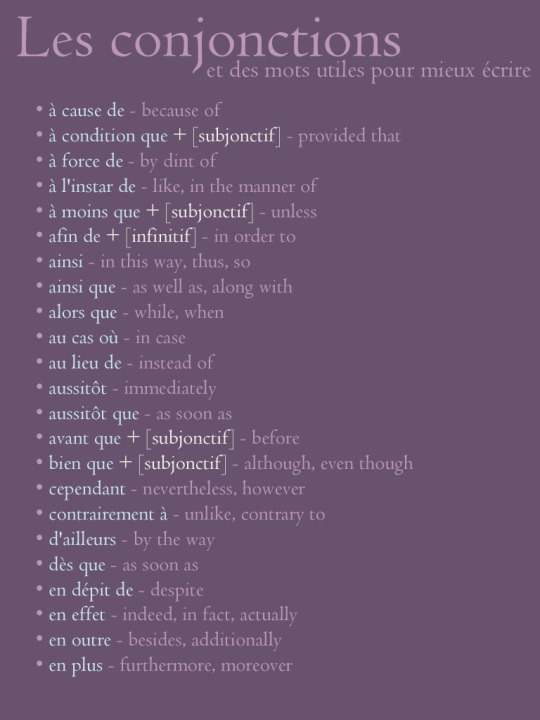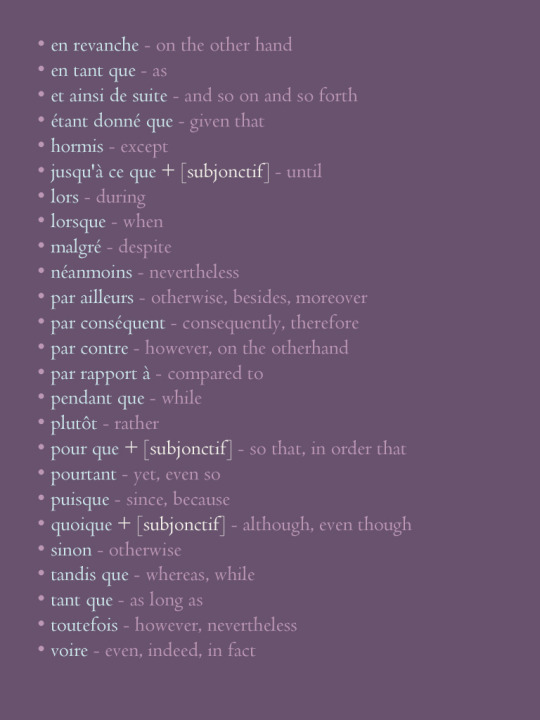INTJ | Interested in Psychology and Medicine ||Slytherin through and through| Currently in HR | Digital Planner Creator
Don't wanna be here? Send us removal request.
Photo

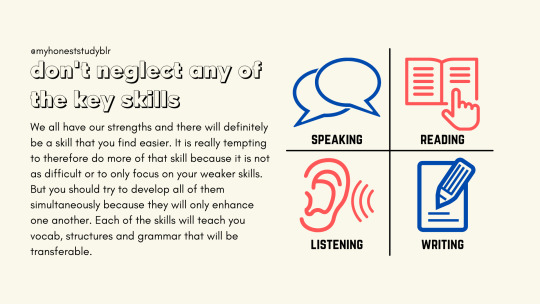



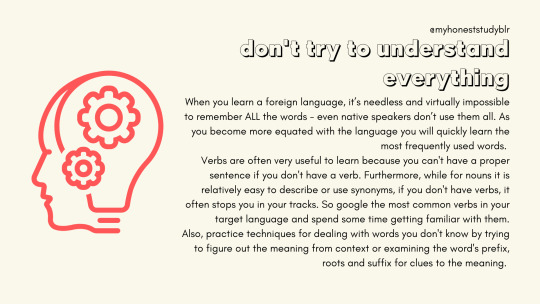
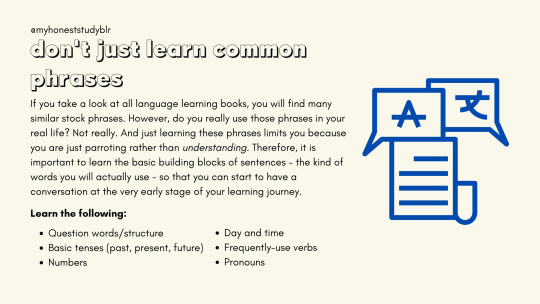
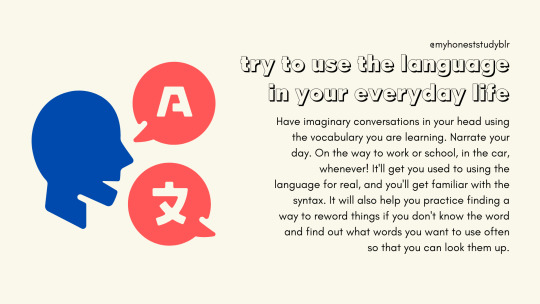


my masterpost | my studygram | ask me anything
[click images for high quality]
[transcript under the cut]
Other advice posts that may be of interest:
How To Study When You Really Don’t Want To
How To Do Uni Readings
Active Revision Tips
Okumaya devam et
8K notes
·
View notes
Text


Rain, tea, research & zoom study session
We do zoom sessions almost every day now, sometimes even for the whole day. When we're not studying, we’re doing chores or one of us is reading and the other watching a movie. It really helps during lockdown.
2K notes
·
View notes
Photo

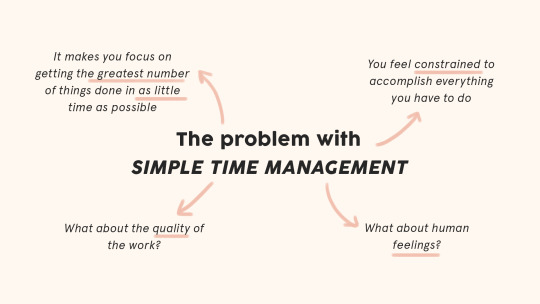
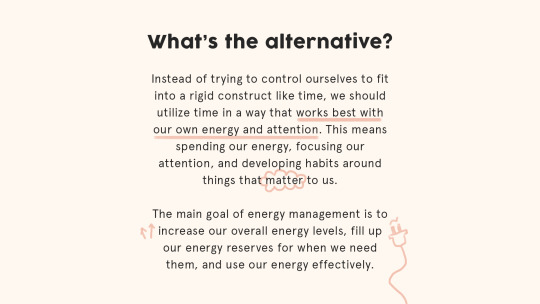
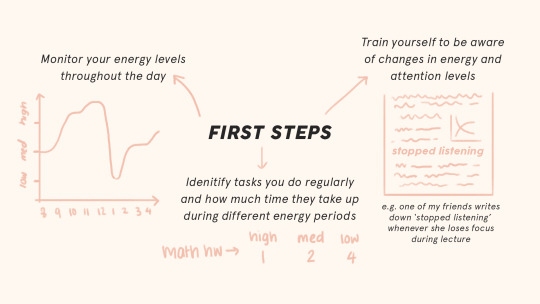

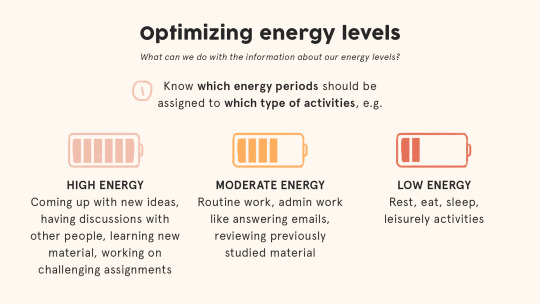
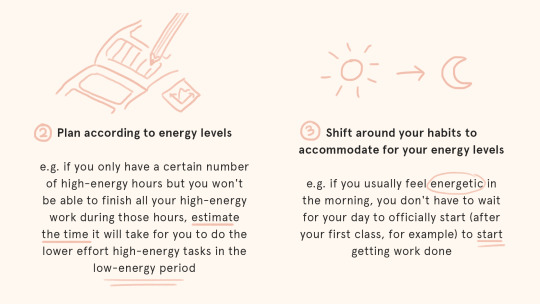
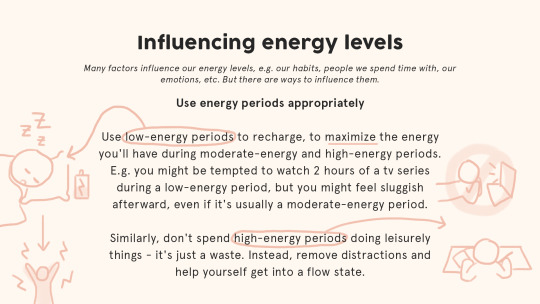
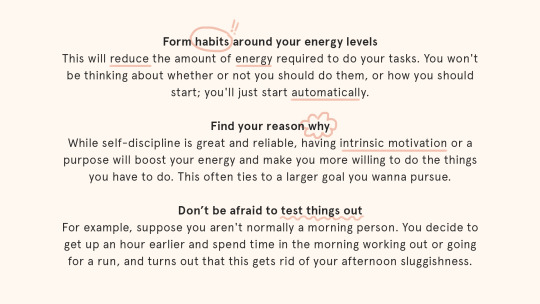
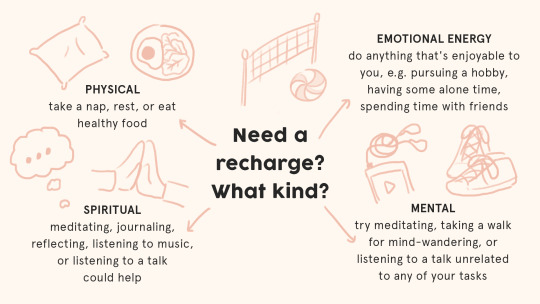
Energy Management
A human-based organization method
click on images for better resolution; images also available here (link to google drive)
Other posts that may be of interest:
Getting stuff done: How to deal with a lack of motivation
Flexible time-blocking: A more breathable way to get things done
The ABCDE Method
30K notes
·
View notes
Photo

Here’s PART 2 of les chiffres: 60~100 +
The 60’s follow the same pattern seen in 20~59.
However, 70~99 is a bit different. In standard French there are no separate words for seventy, eighty or ninety like in English (NOTE: some other French speaking nationalities do have separate words).
SEVENTY:
Is counted as sixty + ten (eleven, twelve, thirteen…etc).
Therefore, soixante + dix = soixante-dix.
All words after soixante are hyphenated, except 71.
71 = is sixty and eleven = soixante et onze (similar to vingt et un, trente et un…etc.)
EIGHTY:
Has another pattern altogether. Eighty is considered as ‘four twenties’ (20 x 4 = 80). Therefore, it is quatre-vingts.
It is counted as four-twenties + one (two, three, four etc.)
So, 81 = quatre-vingt-un. Note that there's no and/et, the words are just hyphenated.
NOTE: from 81~99 the ’s’ in quatre-vingtsdrops off:
82 = quatre-vingt-deux; 83 = quatre-vingt-trois…etc.
NINETY:
Is counted as 'four-twenties plus ten’ (+ eleven, twelve…etc.). So, 90 is quatre-vingt-dix.
91=quatre-vingt-onze; 92=quatre-vingt-douze…etc.
HUNDREDS:
The word for ’(a) hundred’ = cent. Therefore, 100 = cent.
For all other multiples of 100 (ie. 200, 300 etc.) it becomes cents, with an s. It loses the ’~s’ when other numbers follow. Unlike English, there is no 'and’ between the 'hundred’ and the 'tens’ column.
E.g. (345) three-hundred and forty-five = trois cent quarante-cinq.
94 notes
·
View notes
Photo

Les verbes au passé simple: des verbes réguliers
The passé simple is a tense that replaces the passé composé in literary writing (articles, books etc.). You will probably not have to conjugate this tense yourself very often, but it is important to recognise it for when you read literature.
NB: I’ve included “oir/oire” as a category, as this is a common pattern. Same goes for verbs that conjugate to the last letter ‘u’ for the past participle
e.g. connaître –> connu –> connus etc. (follows passé simple pattern for 'oir/oire’)
<<<<<< If I’ve made a mistake, please tell me so I can correct it. Thank you >>>>>>
771 notes
·
View notes
Link
Here’s a site that’s pretty in depth for pronunciation; you can press play and listen to the vowels etc.
39 notes
·
View notes
Photo

This is le conditionnel présent
It is formed by using the stem of the verb used in le futur simple (the future) and adding the endings used in the l'imparfait (the imperfect past tense).
The endings are the same for all verbs!
E.g.
être → ser~ (le futur simple) → ser + ais, ais, ait etc. → serais
avoir → aur~ (le futur simple) → aur + ais, ais, ait etc. → aurais
So even if the verb is irregular in the future tense, it will form in the same way as other verbs.
NOTE:
For verbs that end in e + consonne + er ou é + consonne + e
se lever → je me lèverais
espérer → j'espérerais
Also note:
s'appeler → je m'appellerais
jeter → jetterais
Have I made a mistake? Please let me know :)
111 notes
·
View notes
Photo

13.04.2019| On the final leg of my Masters program. Final exams these days and the preparation is going on
5 notes
·
View notes
Text
Spanish Text Talk Phrases
So, for those of you who don’t know, I went on a search for quite a while for Spanish text talk / internet slang that Spanish-speaking people use. I did get a few responses, but earlier today, I finally really found what I was looking for through a course on Mango Languages. Mango is a fantastic program for anyone looking to start a new language, and it’s free through some libraries. However, not many libraries do offer it, and I only have it because mine does. Having said that, I figured I’d share what I found with all of you! Here you go.
K? - ¿Qué? (This was adapted in more recent years with the spread of the English language. Typing ‘K?’ simply means “What?”)
K haces? - ¿Qué haces? (A shorter, more informal way of asking, “What are you doing?”. It’s an equivalent to “Wyd?”)
Kieres? - ¿Quieres? (Another example of the qu being replaced with a k. You can pretty much do that with any word that starts with qu in Spanish. Simply put, this translates to “You want it?” or “You want one?”)
X k? - ¿Por qué? (The multiplication symbol, x, is read in Spanish as “por”, as in 5 x 5 is read as “cinco por cinco”. Therefore the x is understood as “por”. The k, as i explained before, is read as “qué”. Put those two together, and you have the Spanish word for “Why?” or the English text talk equivalent “y?”)
X fis - Por fis (A more casual version of “por favor”, which means “please”. This is the Spanish equivalent to “Pls”)
Ntc - No te creas (Literally translated, this comes out to “don’t believe you”, but it’s understood as “just kidding”. Ntc is the acronym for that and therefore is the Spanish equivalent to “jk”)
Tkm / Tqm - Te quiero mucho (You might see it as tkm or tqm, but either way, they mean the same thing. Literally translated, “te quiero mucho” means “i love you so much”. That said, the English text talk equivalent is “ily” or “ilysm”)
Bb - Bebé (This simply means “baby” or “babe” and can be used here as a term of endearment. The English equivalent would be something like “bb” or “bby”
Jajaja / jjj - hahaha (This wasn’t part of the course, but I’ve seen it online from Spanish-speaking friends on Facebook, so I figure I’d throw it in there. Congratulations. You now know how to laugh in Spanish.)
I’ve also seen Spanish-speaking people use English text talk too, though. I was texting someone earlier today, and he used “lol” even though the entire conversation was in Spanish. Just thought I’d let you all know of that too.
At any rate, I don’t know if or when this will come in handy for anyone, but in case it does, there you have it! And with that, I bid you all goodnight.
3K notes
·
View notes
Photo










Too many times the Spanish language is subjected to a barbaric butchering of its beautiful sound and its harmonious structure. Growing up in the United States I would often hear Spanish being spoken by non-Spanish speakers in a mocking, almost dismissive, way. Luckily, nowadays, there seems to be more of a push for truth. This is my contribution towards that truth.
HOW NOT TO SOUND LIKE A GRINGO WHEN SPEAKING SPANISH
1. NO PROBLEMO
No. Sandwiching an English noun between an el and a letter O, does not make it Spanish; nor is it ingenious anymore. Seen it. Heard it. Next.
2. MI CASA ES SU CASA
This one is sweet. It implies that Latino households are warm and hospitable. This is very true, however, Latinos don’t have to say this because it’s implied! The closest I’ve ever heard to this phrase is: Estás en tu casa. For example; if you ask to use the restroom at someone’s home, they might say: Claro, estás en tu casa. This means, “Of course, you’re in your own home.”
3. MUY CALIENTE!
You might say this if the soup burned your tongue, but never is it used to describe someone’s sex appeal. Spanish has a million and one ways of expressing attraction towards someone. Two of the most commonly used phrases are “¡Qué guapo/a!” and “¡Qué chulo/a!”
4. RAPIDO, RAPIDO! ANDALE, ANDALE! ARRIBA, ARRIBA!
<Sigh> I won’t mention that cartoon mouse as it’s way before the average Tumblr user’s time. However, I have noticed that The Amazing Race contestants love to yell “rapido, rapido!” at taxi drivers from Spanish-speaking countries. I understand where they’re coming from, and I don’t blame them, but this is plain rude. Say this instead: ¿Puede ir un poco más deprisa, por favor?
5. NO COJONES
If you want to tell someone they have no balls, tell them in English! Don’t veil your contempt for someone by misusing the Spanish language. A common way of saying this accurately is: No tienes agallas. It’s strong without being vulgar.
6. COMPRENDE?!
The condescending use of “comprende” when a Spanish speaker does not understand something is the height of humiliation. Try getting some help. If you actually do speak Spanish, there’s another way of saying this: ¿Me hago entender?
7. HASTA LA VISTA
I’ve never heard any Spanish speakers ever say this. Along with adiós, “hasta la vista” is seriously misused and abused. Read my previous post on other ways of saying adiós by clicking <HERE>.
8. AMIGO
Yes, Spanish-speaking people are friendly, but that does not make them your amigo. Wait for them to call you “mi parce” or “mi compa” before you reciprocate. True amigos don’t call each other amigo.
9. NO BUENO
This popular phrase is incorrect on so many levels. At best, it sounds like a phrase that a Spanish-speaker might put together during early infancy. To learn the different ways to express that something is not good click <HERE>.
6K notes
·
View notes
Text
Spanish Grammar Resources
The lovely @studywithbyu came to looking for some help with Spanish grammar, so here is a little masterlist! (warning, not so little - long post ahead!) I highly suggest checking out both resources because they cover different things and one may provide the information in a better format for you.
Grammar with SpanishDict
A great resource with reliable translations and instruction! I go here instead of to Google Translate because I know it’s much more helpful and accurate. It also has forums for individual questions.
Here is a list of all its lessons:
Adjectives
Descriptive adjectives (regular and irregular)
Adjective placement
Nationalities as adjectives
Short form adjectives (apocopation)
Possessive adjectives
Cardinal numbers (0-100)
Cardinal numbers (101+)
Ordinal numbers
Negatives and negation
Asking questions: interrogatives
Comparisons of inequality
Comparisons of equality
Superlatives - the best, worst, most, & least
Using adjectives as nouns
Relative adjectives (cuyo)
Demonstrative adjectives
Exclamatory words
Adverbs
Adverb forms and placement
Articles
Definite article forms (regular and exceptions)
Definite Article Uses
Indefinite article forms (regular and irregular)
Indefinite article uses
Neuter article
Conjunctions
Conjunctions
Gender
Masculine and feminine nouns
Professions and other nouns with both masculine and feminine forms
Number
Plural forms of nouns (regular and exceptions)
Prepositions
Basic Prepositions
Basic por vs. para (motion vs. destination)
Contractions
Advanced por vs. para (DREEMS vs. PRODDS)
Advanced expressions with por and para
Pronouns
Subject pronouns (personal pronouns)
Spanish “you” - (tú, vos, usted, vosotros, ustedes)
Object pronouns (pronouns after prepositions)
Direct Object Pronouns
Direct object pronoun placement
Indirect Object Pronouns
Indirect object pronoun placement
Possessive pronouns
Neuter possessive pronouns
Using direct and indirect object pronouns together
Demonstrative pronouns
Relative pronouns (que, quien, el que, el cual)
Neuter relative pronouns (lo que, lo cual)
Impersonal se
Impersonal se vs. passive se
Passive se
Pronunciation
Spanish Alphabet and Pronunciation
Spanish vowels
Spanish syllables
Word stress
Written accents (tildes)
Spanish punctuation
Verbs
Infinitive forms and finding stems for regular verbs
Other uses for infinitives
Present Participles
Other uses for the present participle (gerundio)
Past participle regular forms and uses
Irregular and stressed past participles
Present perfect - Using haber with past participles
Present Tense Forms
Present tense spelling changes
Stem Changing Verbs
Irregular present tense
Verbs like gustar
Basic ser vs. estar - D.O.T. vs. Lo.Co.
Uses of ser: descriptions
Uses of ser: origins
Uses of ser: time
Uses of estar: Location
Uses of estar: condition
Informal future (ir + a + infinitive)
Imperfect Tense Forms
Spanish Preterite Tense Forms
Spelling changes in the preterit
Stem changes in the preterit
Verbs that change meaning in the preterit
Preterit vs. Imperfect - differences and signifier phrases
Affirmative informal (tú) commands
Negative Tú Commands
Formal Affirmative and Negative Commands
Subjunctive vs. Indicative
Wishes & wants in the subjunctive
Emotions with the subjunctive
Impersonal expressions with the subjunctive
Recommendations & requests with the subjunctive
Doubts & denial with the subjunctive
Ojalá with the subjunctive
Uncompleted or prospective actions with the subjunctive
Present Subjunctive Regular and Irregular Forms
Present Progressive Forms
Saber vs. Conocer
Pedir vs. preguntar (to ask)
Reciprocal verbs and pronouns
Reflexive Verbs and Pronouns
Active vs. passive voice
Nosotros commands
Indirect commands
Imperfect progressive
Simple future regular forms and uses
Simple future irregular and stem changing forms
Hacer with expressions of time
Conditional regular and irregular forms and uses
Imperfect Subjunctive
Future subjunctive forms and uses
Past perfect forms and uses
Preterit perfect
Present Perfect Subjunctive
Future perfect
Conditional perfect forms and uses
Past Perfect Subjunctive Forms
Future perfect subjunctive forms and uses
Verb structures (transitive, intransitive, pronominal)
Ir vs. irse
Verbal periphrasis
Indicative mood
Imperative mood
Copular Verbs
________________________________________________________________
Spanish Grammar @ StudySpanish.com
Nine units full of very useful grammar! I plan to use this one myself for a bit of self-instruction before I go to Catalonia. My favorite part is it gives you flashcard ideas and has review.
Here are the units and their topics:
UNIT ONE
1. Gender of Nouns I
2. Gender of Nouns II
3. Numbers: 1-10
4. Plural Forms of Nouns
5. Def. & Indef. Articles
6. The Verb Form “hay”
7. Subject Pronouns
8. Reg. Verbs I
9. Reg. Verbs II
10. Reg. Verbs III
11. Adjectives I
12. Adjectives II
13. Days of the Week
14. Numbers: 11-30
UNIT TWO
15. Ser and Estar I
16. Ser and Estar II
17. Ser and Estar III
18. Ser and Estar IV
19. Negation
20. Questions
21. Poss. Adjectives
22. Tener, venir
23. Tener que / Hay que
24. Exp. with “Tener”
25. Weather Expressions
26. The Personal “a”
27. Contractions
UNIT THREE
28. Stem-Changing Verbs: o:ue
29. Stem-Changing Verbs: e:ie
30. Stem-changing verbs: e:i
31. Estar, Ir, Dar
32. “Ir a” + infinitive
33. Acabar de
34. Volver a
35. Ordinal Numbers
36. Months, Seasons, and Dates
37. Comparisons of Inequality
38. Comparisons of Equality
39. Superlatives
UNIT FOUR
40. Pronouns as Objects of Prepositions
41. Dir. Object Pronouns I
42. Dir. Object Pronouns II
43. Dir. Object Pronouns III
44. Ind. Object Pronouns I
45. Ind. Object Pronouns II
46. Ind. Object Pronouns III
47. DO and IO Pronouns Together
48. Verbs Like Gustar
49. Present Progressive
50. Verbs with Irregular 1st Persons
UNIT FIVE
51. Saber vs Conocer / Pedir vs Preguntar
52. Numbers: 31-1000
53. Telling Time
54. Por and Para
55. Irreg. Comparatives
56. Demonstratives
57. Time Expressions With Hacer
58. Possessive Pronouns
59. Reflexive Verbs I
60. Reflexive Verbs II
61. Definite Article II
UNIT SIX
62. Pret. vs Imp. I
63. Preterite I
64. Imperfect I
65. Preterite II
66. Imperfect II
67. Pret. vs Imp. II
68. Preterite III
69. Imperfect III
70. Preterite IV
71. Preterite V
72. Preterite VI
73. Pret. vs Imp. III
74. Pret. vs Imp. Review
UNIT SEVEN
75. “Hace …” to mean “ago”
76. Formation of Adverbs
77. Subjunctive I: Introduction
78. Subjunctive II: Conjugating regular and stem-changing verbs
79. Subjunctive III: Verbs that change orthographically
80. Subjunctive IV: Irregular verbs
81. Subjunctive V: Desire
82. Subjunctive VI: Ignorance, doubt
83. Subjunctive VII: Impersonal Expressions
84. Subjunctive VIII: Actions not yet completed
UNIT EIGHT
85. Rel. Pronouns - que
86. Rel. Pronouns - quien
87. Rel. Pronouns - el que and lo que
88. Rel. Adjective - cuyo
89. Rel. Pronouns and Adjectives - Review
90. Formal Commands
91. Inform. Commands - tú
92. Irreg. Commands - tú
93. Using Object Pronouns with Commands
94. Commands Review I
95. Informal Commands - vosotros
96. 1st Person Commands - nosotros
97. Indirect Commands
98. Commands Review II
UNIT NINE
99. Future
100. Past Participle
101. Present Perfect
102. Past Perfect
103. Future Perfect
104. Conditional
I hope this helps!
________________________________________________________________
Some other good websites:
121Spanish
PracticingSpanish
Rocket Languages
And if you plan to practice writing and don’t have a native speaker or proficient learner to help, here’s a Spanish editor!
Spanish Checker
5K notes
·
View notes
Text
Interesting Reviews for Week 11, 2018
Integration of objects and space in perception and memory. Connor, C. E., & Knierim, J. J. (2017). Nature Neuroscience, 20(11), 1493–1503.
A Factor Graph Description of Deep Temporal Active Inference. de Vries, B., & Friston, K. J. (2017). Frontiers in Computational Neuroscience, 11, 95.
The cognitive map in humans: spatial navigation and beyond. Epstein, R. A., Patai, E. Z., Julian, J. B., & Spiers, H. J. (2017). Nature Neuroscience, 20(11), 1504–1513.
Field repetition and local mapping in the hippocampus and the medial entorhinal cortex. Grieves, R. M., Duvelle, É., Wood, E. R., & Dudchenko, P. A. (2017). Journal of Neurophysiology, 118(4), 2378–2388.
Does Epileptiform Activity Represent a Failure of Neuromodulation to Control Central Pattern Generator-Like Neocortical Behavior? Traub, R. D., Whittington, M. A., & Hall, S. P. (2017). Frontiers in Neural Circuits, 11, 78.
12 notes
·
View notes
Photo

I believe in free education, one that’s available to everyone; no matter their race, gender, age, wealth, etc… This masterpost was created for every knowledge hungry individual out there. I hope it will serve you well. Enjoy!
FREE ONLINE COURSES (here are listed websites that provide huge variety of courses)
Alison
Coursera
FutureLearn
open2study
Khan Academy
edX
P2P U
Academic Earth
iversity
Stanford Online
MIT Open Courseware
Open Yale Courses
BBC Learning
OpenLearn
Carnegie Mellon University OLI
University of Reddit
Saylor
IDEAS, INSPIRATION & NEWS (websites which deliver educational content meant to entertain you and stimulate your brain)
TED
FORA
Big Think
99u
BBC Future
Seriously Amazing
How Stuff Works
Discovery News
National Geographic
Science News
Popular Science
IFLScience
YouTube Edu
NewScientist
DIY & HOW-TO’S (Don’t know how to do that? Want to learn how to do it yourself? Here are some great websites.)
wikiHow
Wonder How To
instructables
eHow
Howcast
MAKE
Do it yourself
FREE TEXTBOOKS & E-BOOKS
OpenStax CNX
Open Textbooks
Bookboon
Textbook Revolution
E-books Directory
FullBooks
Books Should Be Free
Classic Reader
Read Print
Project Gutenberg
AudioBooks For Free
LibriVox
Poem Hunter
Bartleby
MIT Classics
Many Books
Open Textbooks BCcampus
Open Textbook Library
WikiBooks
SCIENTIFIC ARTICLES & JOURNALS
Directory of Open Access Journals
Scitable
PLOS
Wiley Open Access
Springer Open
Oxford Open
Elsevier Open Access
ArXiv
Open Access Library
LEARN:
1. LANGUAGES
Duolingo
BBC Languages
Learn A Language
101languages
Memrise
Livemocha
Foreign Services Institute
My Languages
Surface Languages
Lingualia
OmniGlot
OpenCulture’s Language links
2. COMPUTER SCIENCE & PROGRAMMING
Codecademy
Programmr
GA Dash
CodeHS
w3schools
Code Avengers
Codelearn
The Code Player
Code School
Code.org
Programming Motherf*?$%#
Bento
Bucky’s room
WiBit
Learn Code the Hard Way
Mozilla Developer Network
Microsoft Virtual Academy
3. YOGA & MEDITATION
Learning Yoga
Learn Meditation
Yome
Free Meditation
Online Meditation
Do Yoga With Me
Yoga Learning Center
4. PHOTOGRAPHY & FILMMAKING
Exposure Guide
The Bastards Book of Photography
Cambridge in Color
Best Photo Lessons
Photography Course
Production Now
nyvs
Learn About Film
Film School Online
5. DRAWING & PAINTING
Enliighten
Ctrl+Paint
ArtGraphica
Google Cultural Institute
Drawspace
DragoArt
WetCanvas
6. INSTRUMENTS & MUSIC THEORY
Music Theory
Teoria
Music Theory Videos
Furmanczyk Academy of Music
Dave Conservatoire
Petrucci Music Library
Justin Guitar
Guitar Lessons
Piano Lessons
Zebra Keys
Play Bass Now
7. OTHER UNCATEGORIZED SKILLS
Investopedia
The Chess Website
Chesscademy
Chess.com
Spreeder
ReadSpeeder
First Aid for Free
First Aid Web
NHS Choices
Wolfram Demonstrations Project
Please feel free to add more learning focused websites.
*There are a lot more learning websites out there, but I picked the ones that are, as far as I’m aware, completely free and in my opinion the best/ most useful.
532K notes
·
View notes
Text
Psychology Book Recommendations
Foundational Authors & Works
Carl Rogers, On Becoming a Person
B. F. Skinner, Beyond Freedom and Dignity and About Behaviorism and Walden Two
Viktor Frankl, Man’s Search for Meaning
Sigmund Freud, Civilization and its Discontents
John Norcross (editor), Evidence-Based Practices in Mental Health
Psychopathology & Diagnosis
David Barlow (editor), Clinical Handbook of Psychological Disorders
Oliver Saks, Hallucinations
Kelly Lambert, Clinical Neuroscience
Criticisms & Controversial Topics
Stephen Hinshaw, The ADHD Explosion
Robert Whitaker, Mad in America and Anatomy of an Epidemic
Ronald Miller, Not So Abnormal Psychology
Allen Frances, Saving Normal
Bruce Wampold, The Great Psychotherapy Debate
Therapy Theories
Carl Rogers, Client-Centered Therapy
Irvin Yalom, The Theory and Practice of Group Psychotherapy
Aaron Beck, Cognitive Therapy of Depression
Steven Hayes, Acceptance and Commitment Therapy
Judith Beck, Cognitive Behavioral Therapy
Danny Wedding, Current Psychotherapies
William Miller, Motivational Interviewing
Jacqueline Person, Cognitive Therapy in Practice
Evidence-Based Therapy Manuals
Marsha Linehan, DBT Skills Training Manual and Cognitive Behavioral Treatment of Borderline Personality Disorder
Michelle Craske, Mastery of Your Anxiety and Panic
David Burns, Feeling Good
Richard Zinbarg, Mastery of Your Anxiety and Worry
Martha Davis, The Relaxation and Stress Reduction Workbook
Lisa Najavitis, Seeking Safety
Expert Therapist Perspectives
Irvin Yalom, The Gift of Therapy and Love’s Executioner
First Person Perspectives
Kay Jamison, An Unquiet Mind
Elyn Saks, The Center Cannot Hold
William Styron, Darkness Visible
Carolyn Spiro and Pamela Spiro Wagner, Divided Minds
Research Design & Analysis
Alan Kazdin, Research Design in Clinical Psychology and Single-Case Research Designs
John Creswell, Qualitative Inquiry and Research Design
Culture & Diversity
Derald Wing Sue, Counseling the Culturally Diverse and Case Studies in Multicultural Counseling and Therapy
Stigma
Stephen Hinshaw, Breaking the Silence and The Mark of Shame
Grad School and Careers in Psychology
Peggy Hawley, Being Bright is Not Enough
Adam Ruben, Surviving Your Stupid, Stupid Decision to Go to Grad School
Peter Feibelman, A PhD is Not Enough
Paul Silva, How to Write A Lot
Karen Kelsky, The Professor Is In
2K notes
·
View notes
Photo

26.10.17| Cause you gotta put in work, work, work, work📚 And also a little motivation🍹
6 notes
·
View notes
Photo

Wolves Understand Cause and Effect Better Than Dogs
A good example of the connection between cause and effect, is that an object which contains food produces noise when shaken. The study of an international research team at the Wolf Science Center of the Vetmeduni Vienna shows how animals deal with these rules of the physical world. Based on where dogs and wolves searched for food after receiving some hints about its location, they showed that our domesticated, four-legged companions cannot make the connection between cause and effect, but wolves can. These results indicate that domestication has changed the dogs’ cognitive abilities.
The research is in Scientific Reports. (full open access)
181 notes
·
View notes
